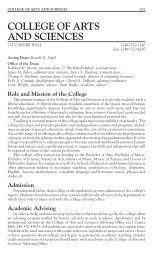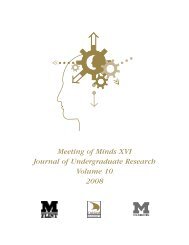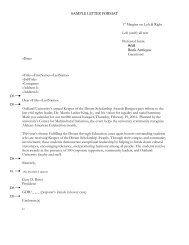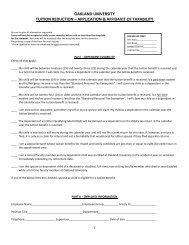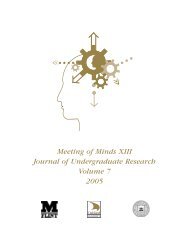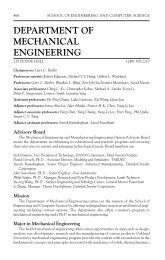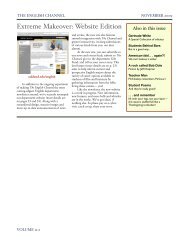MOM 2006 journal for pdf.pmd - University of Michigan-Flint
MOM 2006 journal for pdf.pmd - University of Michigan-Flint
MOM 2006 journal for pdf.pmd - University of Michigan-Flint
Create successful ePaper yourself
Turn your PDF publications into a flip-book with our unique Google optimized e-Paper software.
In studies <strong>of</strong> age related declines in inhibition, negative priming may be the most appropriate<br />
indicator <strong>of</strong> inhibition. Negative priming occurs when the in<strong>for</strong>mation to be ignored on the prime<br />
trial becomes the target response on the next trial. For example, if the word ‘yellow’ is presented<br />
in red ink on the first trail the target response is ‘red’ and ‘yellow’ is to be ignored Negative<br />
priming occurs when the next trial requires that the participant respond ‘yellow’ which should be<br />
slowed because the participant may still be suppressing that response. Failure to respond<br />
correctly or very slow response times reflects interference from previously-relevant in<strong>for</strong>mation,<br />
or perseveration. It is possible that participants actually tag (mentally) the non-response<br />
in<strong>for</strong>mation and that this is problematic when these words (or other in<strong>for</strong>mation) become the<br />
response shortly thereafter (Little & Hartley, 2000).<br />
Hasher et al (1991) studied the carryover effects <strong>of</strong> negative priming on older adults using a<br />
letter-naming task. Subjects were presented with a pair <strong>of</strong> letters, a distractor and the target, and<br />
asked to either name the red or green letter. Negative priming conditions used the distractor letter<br />
<strong>of</strong> previous trials were used as the target letter on the next trial. Results revealed that younger<br />
adults had significantly slower response times on the negative priming condition. Hasher et al<br />
(1991) attribute the lack <strong>of</strong> negative priming effect on older adults to the inability <strong>of</strong> processing<br />
the distractor on the prime trial, thus there was no carryover effect to the next trial.<br />
In our study susceptibility to interfering in<strong>for</strong>mation and perseveration were both measured<br />
using the Stroop task. We included the young -old and old-old populations to study age effects in<br />
inhibitory processes, with particular emphasis on the per<strong>for</strong>mance <strong>of</strong> the old-old compared to the<br />
other two groups. Our hypothesis is that the largest age differences will be associated with the<br />
negative priming task, the next largest with the interference task, and the smallest with the color<br />
naming task. Specifically, the old-old, 75 years or older, will display the most susceptibility to<br />
random interference and perseveration or have the largest effect size (the biggest effect <strong>of</strong> age on<br />
Stroop per<strong>for</strong>mance).<br />
Method<br />
Participants<br />
Participants included 190 community dwelling adults. Of these 190 participants, 67 were aged<br />
18-35, 60 aged 60-74, and 63 aged 75 and older. Please see Table 1.<br />
Table 1: Sample Demographics<br />
Young Young-Old Old-Old<br />
Range 18-35 60-74 75+<br />
N 67 60 63<br />
Education 12.81 14.24 13.46<br />
MMSE 29.12 28.12 27.43<br />
Meeting <strong>of</strong> Minds <strong>2006</strong> 5



